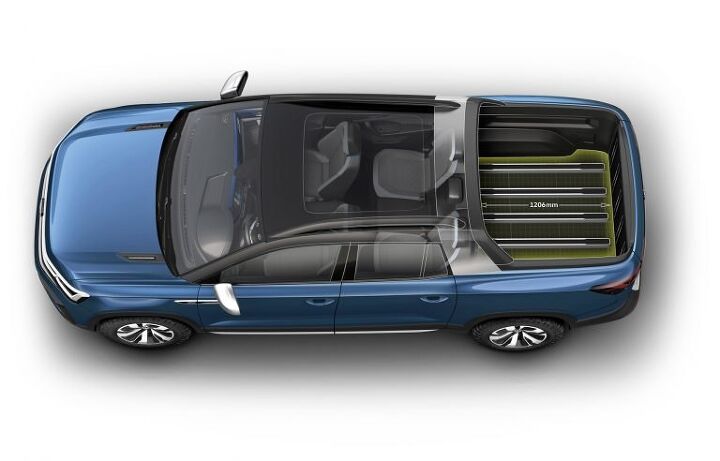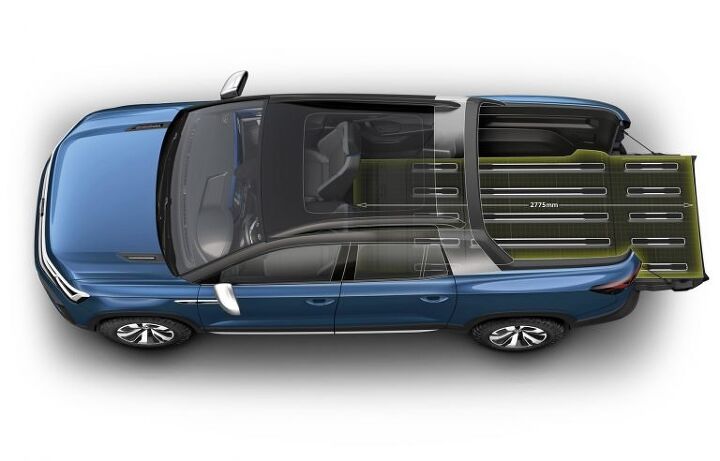Volkswagen's Tarok Pickup Should Give Hyundai Food for Thought

A new Volkswagen pickup for Brazil? Yawn. As much as small, cheap pickups turns this writer’s crank, the image that came to mind upon hearing news of this week’s São Paulo unveiling was a weird amalgam of the late Ford Courier and VW Fox.
Then I looked at pictures of the VW Tarok concept, which is said to almost exactly mirror the production vehicle bound for that market. My, my — what a fetching little truck. Sporting pretty much the exact same wheelbase of the Atlas and bearing a bed that extends in both directions, the MQB-platform vehicle is a versatile and stylish little unibody runabout.
Isn’t this pretty much what Hyundai has in mind for North America, assuming it pulls the trigger on the Santa Cruz?
Hyundai’s waffled on that decision since early 2015, and, while initial R&D work is ongoing, it’s still not certain that we’ll ever see it come to fruition. The earliest we’d see production start on the Santa Cruz — described as a four-seat unibody pickup with an extendable bed, positioned below today’s midsize offerings — is in two years.
The Santa Cruz is a ghost, but the Tarok is real. With Hyundai unable to provide us with any images of their vision, we’re left with the Tarok to gaze upon, wondering whether there’s room in the North American market for a vehicle of this size and layout.
Being of Latin American intent, the Tarok makes do with a turbocharged 1.4-liter four-cylinder plucked directly from the Jetta. The 150 horsepower and 184 lb-ft of torque on tap (a six-speed automatic is standard, as is all-wheel drive) is hardly Ford Raptor territory, though VW plans to outfit the production model with a 2.0-liter turbodiesel. Other markets, should VW choose to venture there, could see different powerplants. Perhaps the Atlas’ base turbo 2.0L gas engine would be of use. Still, that’s only a hypothetical for now. Latin America is the model’s home, and VW plans to gauge interest before deciding whether to expand the Tarok’s availability to other regions.
One thing’s for sure — you’ll never see it here. The automaker confirmed to Motor Authority that the Tarok will never be sold in the U.S., even if its reach expands. That means if Hyundai ever comes to a decision on its Santa Cruz, it will have the niche to itself.
Let’s take a closer look at the Tarok. While the VW Tanoak concept revealed in New York this spring boasts greater distance its wheels hubs than the Atlas, the Tarok’s underpinnings are essentially unchanged from the three-row crossover. Despite the car-based architecture, both trucks boast a ground clearance of just shy of 10 inches. The smaller Tarok’s bed measures a scant 3.96 feet; good for cordwood, but not for lumber. However, a full-width folding partition allows owners to repurpose cabin space once they’ve folded down (or removed) the rear seats.
Give those rear seats a flip, open the partition, and objects 6.11 feet in length can lie flat in the bed, tailgate up. Lower the gate, and there’s 8.36 feet of bed length. Remove the rear seats, the total bed length expands to 9.1 feet, though you’d certainly want a bed extender to keep items from turning into road debris. Careful of the rear glass when you’re shoving rebar and God knows what else back there.
Besides the versatility, the Tarok looks good in spite its blunt profile. The high character line reduces bloat, and the dark-colored A- and B-pillars allow the rakish, metallic finish baskethandle C-pillar to literally and figuratively shine. It’s enough to make you think about just much truck you really need to own. I have to wonder if it’s making Hyundai think, too.
[Images: Volkswagen Group]

More by Steph Willems
Latest Car Reviews
Read moreLatest Product Reviews
Read moreRecent Comments
- Lou_BC Well, I'd be impressed if this was in a ZR2. LOL
- Lou_BC This is my shocked face 😲 Hope formatting doesn't fook this up LOL
- Lou_BC Junior? Would that be a Beta Romeo?
- Lou_BC Gotta fix that formatting problem. What a pile of bullsh!t. Are longer posts costing TTAC money? FOOK
- Lou_BC 1.Honda: 6,334,825 vehicles potentially affected2.Ford: 6,152,6143.Kia America: 3,110,4474.Chrysler: 2,732,3985.General Motors: 2,021,0336.Nissan North America: 1,804,4437.Mercedes-Benz USA: 478,1738.Volkswagen Group of America: 453,7639.BMW of North America: 340,24910.Daimler Trucks North America: 261,959






































Comments
Join the conversation
Pretty soon VW will have this Turok thing plus a rebadged Ford Ranger to play with.
"does the Tarok or the Santa Cruz concept appeal to you in any meaningful way?" No. But I'm not the target market. This strikes me as more of an effort to create world cars that can use a few US sales to amortize their costs. The primary markets are probably Asia for Hyundai and Latin America for VW; since they want to sell in those markets, they may as well include us. It seems that more and more decisions are being made based upon global tastes, rather than regional demand. Hence, a US-oriented Mustang being adjusted so that it can also serve a few Europeans, while Americans get Ecosports that weren't really envisioned with the US being the primary market. In the past, the major automakers avoided this sort of thing before because it wasn't usually possible to use the same car to please everyone. But they seem to be having a change of heart.